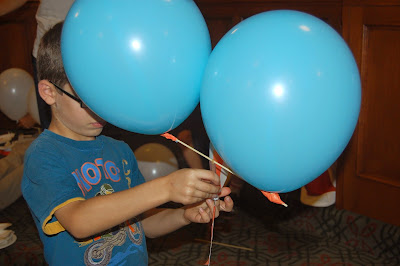Suspension Bridges
We've started up Curiosity Machine again! For yesterday's Curiosity Machine classes, we built suspension bridges! This is one of the civil engineering challenges on Curiositymachine.org.
First we learned how spiders build their webs:
https://www.youtube.com/watch?v=9qaaYlpVmJM
This picture from p. 21 of Do All Spiders Spin Webs? by Melvin and Gilda Berger, Illustrated by Roberto Osti and published by Scholastic illustrates the process of a spider web very well: Then we learned about the basics of suspension bridge design, how the cables help a bridge to hold firm and strong and balance out all the forces acting on it in all directions. I showed the kids this page from the book Bridges! Amazing Structures to Design, Build & Test by Carol A. Johmann and Elizabeth J. Rieth, published by Williamson Publishing: We learned about John Roebling, the great engineer behind the Brooklyn Bridge, and how he also strengthened the Niagra Bridge with more trusses and stays. After learning a lot about bridge building, the kids got their gumdrops, toothpicks, and other materials and got to work building a bridge! Below you see the bridge that I built out of toothpicks and gummies alone. No yarn suspension cables. I showed the kids how easily it buckled under stress, so that they could appreciate how much better their suspension cables would be for their bridges. Toothpicks are not that strong by themselves, but with yarn tied to suspension towers and the tension of taping that yarn down tight, they are really bolstered up and the forces are balanced. Once the kids put together their bridge out of gummies and toothpicks they made suspension towers out of cups and suspension cables out of yarn and sealed it all tightly with tape. After doing this we tested their bridges with a cup of marbles. When the bridges remained strong, the kids kept wanting to add more weight! So we added all kinds of things--shoes, cups full of scissors, boxes of paperclips, rolls of tape. Whatever we could find, we tested! And because of the superior design of a suspension bridge, the bridges nearly all stayed up. If you'd like to see the whole powerpoint presentation, here it is: Everybody had a good time!
https://www.youtube.com/watch?v=9qaaYlpVmJM
This picture from p. 21 of Do All Spiders Spin Webs? by Melvin and Gilda Berger, Illustrated by Roberto Osti and published by Scholastic illustrates the process of a spider web very well: Then we learned about the basics of suspension bridge design, how the cables help a bridge to hold firm and strong and balance out all the forces acting on it in all directions. I showed the kids this page from the book Bridges! Amazing Structures to Design, Build & Test by Carol A. Johmann and Elizabeth J. Rieth, published by Williamson Publishing: We learned about John Roebling, the great engineer behind the Brooklyn Bridge, and how he also strengthened the Niagra Bridge with more trusses and stays. After learning a lot about bridge building, the kids got their gumdrops, toothpicks, and other materials and got to work building a bridge! Below you see the bridge that I built out of toothpicks and gummies alone. No yarn suspension cables. I showed the kids how easily it buckled under stress, so that they could appreciate how much better their suspension cables would be for their bridges. Toothpicks are not that strong by themselves, but with yarn tied to suspension towers and the tension of taping that yarn down tight, they are really bolstered up and the forces are balanced. Once the kids put together their bridge out of gummies and toothpicks they made suspension towers out of cups and suspension cables out of yarn and sealed it all tightly with tape. After doing this we tested their bridges with a cup of marbles. When the bridges remained strong, the kids kept wanting to add more weight! So we added all kinds of things--shoes, cups full of scissors, boxes of paperclips, rolls of tape. Whatever we could find, we tested! And because of the superior design of a suspension bridge, the bridges nearly all stayed up. If you'd like to see the whole powerpoint presentation, here it is: Everybody had a good time!
















Comments
Post a Comment